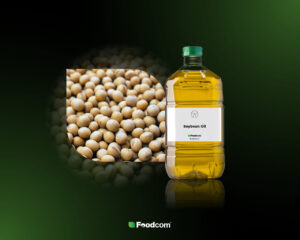- After an intense start to the year, the vegetable oil market stabilised thanks to the recovery of supply in Asia and a solid harvest in Europe.
- Trade is shifting towards medium- and long-term contracts, and the importance of raw material quality and origin is clearly growing.
- Asia maintains its dominant position in exports, North America is strengthening its biofuel segment, and Europe is building its advantage in the area of sustainable processing.
- Certified and low-carbon oils are becoming increasingly important, setting margins and the direction of market development for the coming years.
Market dynamics
Since the beginning of 2025, the palm oil market has been undergoing a continuous price correction. In January, prices hovered around EUR 1,040/MT and in May reached a local minimum in the region of EUR 805/MT. In the following months, quotations gradually recovered, stabilising since August in the EUR 900-920/MT range. These changes were mainly due to differences in export rates and an increase in stocks in producing countries, which limited the potential for further rises. For the moment, the market remains balanced, with price adjustments reflecting short-term fluctuations rather than a sustained trend.
The soybean oil market remains on an upward trend, driven by increasing demand for vegetable oils and high raw material prices. During the first quarter, quotations remained in a range of EUR 920-970/MT, before reaching a local peak in May around EUR 1 030/MT. The price increase was supported by strong demand from the food and biofuel sectors, as well as increased purchases from India, which significantly raised import volumes. Since July, the market has gradually stabilised, with prices settling around EUR 1,000/MT. High trade activity in South America and somewhat limited supply in key regions are keeping the market in balance with relatively high price levels.
The sunflower oil market is characterised by high volatility, mainly due to the supply situation in the Black Sea region. At the beginning of the year, prices remained in the range of EUR 1,320-1,370/MT, but fell to around EUR 1,250/MT in the spring as a result of increased supply from the new harvest. In September, quotations rose to a peak of EUR 1,400/MT supported by sizable exports from Ukraine and increasing demand from Asia. Quotation dynamics remain significant, but the market has managed to maintain its equilibrium thanks to flexible export flows and rebuilding logistics in the region.
Rapeseed oil recorded only mild price corrections. In the first quarter, prices remained in the EUR 1 050-1 080/MT range, before falling slightly in April to around EUR 1 000/MT and rebounding to EUR 1 070/MT in August on the back of demand from the food and biofuel industries. The relative stability is due to the good availability of raw material and relatively even exports, which allowed the supply and demand pattern to remain balanced.
Coconut oil prices were in the region of €2,950-3,000/MT in the first quarter, driven by increasing demand in the cosmetics or food sector. There was a slight correction in the second quarter when increased supply from the Philippines and Indonesia brought prices down to around EUR 2 850/MT. Since July, quotations have been rising again, stabilising in the EUR 2 900-2 950/MT range. The global balance between exports and domestic consumption in producer countries has kept prices high but stable.
Regional analysis
Europe
The European vegetable oil market in 2025 operates in an environment of rising energy costs, environmental pressures and changes in consumption patterns. Demand is shifting towards feedstocks from crops with a smaller carbon footprint, and this favours rapeseed and sunflower oil. The high food inflation of the beginning of the year is gradually receding, but processors’ margins remain squeezed, as seen in lower contracting activity in the first quarter. Following the normalisation of logistics and raw material deliveries from Ukraine, intra-EU trade has regained momentum, so processors can again focus on raw material quality. The European market maintains balance by responding flexibly to changing conditions.
In the second half of the year, the biofuel sector is playing a particular role, absorbing a significant proportion of rapeseed and soya oil supply. Increased demand for biodiesel in Germany, France and the Netherlands is keeping feedstock prices relatively high despite oversupply. Consumers are increasingly opting for oils with higher levels of processing and certification, which supports demand for products from domestic mills. The palm market remains largely import-driven, with restrictions on origin limiting its share of the fat mix. Coconut oil maintains a stable position in the premium segment, especially in the cosmetics and food sectors.
The European vegetable oil market is therefore characterised by a high degree of adaptation. Producers remain resilient to fluctuations in global prices, diversifying import destinations and strengthening local processing. However, the sector remains sensitive to regulatory factors (from biofuel policy to deforestation regulations), which are increasingly influencing purchasing decisions or trade directions.
North America
The North American market operates in an environment of strong domestic demand and stable production. In the United States, the processing sector maintains high capacity and soybean oil remains a key feedstock for both the food and biofuel industries. The rapid growth of the renewable diesel market means that demand for soybean oil continues to grow, keeping its prices relatively high. Canada continues to expand in the rapeseed segment, taking advantage of its logistical advantage and access to Pacific ports, while Mexico is increasing its imports of vegetable oils to offset its domestic feedstock deficit.
The second factor shaping the market remains energy and transport costs, which affect processing profitability and producer margins. Despite rising operating costs, however, US mills remain competitive through integration with the biofuels sector. High oil prices are supporting demand for vegetable feedstocks, as well as federal subsidies for diesel production. At the same time, there is a greater diversification of the feedstock mix, with alternative oils, including those derived from waste or speciality crops, playing an increasingly important role alongside soya and rapeseed.
Despite the fluctuations in feedstock prices at the beginning of the year, the North American market remains balanced thanks to the large scale of production, as well as the logistics infrastructure. The limited global supply of palm oil and sunflower oil has only strengthened the position of local oils (soybean and rapeseed) in the consumption structure. High quality, standardisation as well as long-term contracts with the energy sector ensure that the region remains one of the most stable and profitable links in the global vegetable oil market.
Oceania
Oceania’s oil market remains relatively small, but well integrated into international trade. Australia maintains stable rapeseed production and remains one of the key exporters to Asian markets, especially Japan or South Korea. In the first half of the year, high transport costs as well as limited container availability hampered exports, but the logistical situation has improved since July. Prices for rapeseed and soybean oil in the region remained close to European quotations and the relatively weaker Australian dollar supported the competitiveness of supplies.
New Zealand, despite limited oilseed crop production, is increasing imports of cooking oils, mainly rapeseed and sunflower. A growing interest in biofuels and low carbon feedstocks is evident across the region, influencing the direction of investment in processing. It is becoming particularly important for Australian producers to maintain a balance between exports and local supply, as domestic demand is growing faster than in previous years. The Oceania market remains balanced, based on high-quality raw material and strong links with Asian customers.
Asia
The Asian vegetable oil market remains the most dynamic and diversified in the world. In the first half of the year, rising commodity prices drove strong demand in India, China and Indonesia, which together account for the majority of global cooking oil consumption. In India, demand for soybean and palm oil grew particularly rapidly, partially offsetting declines in the rapeseed sector. China maintained stable import levels, with a focus on supply diversification between South America and Southeast Asia. Across the region, there is a clear shift in preference towards more sustainably sourced raw materials in line with the environmental requirements of major importers.
In the second half of the year, the market gradually stabilises, with participants’ attention focusing on the supply balance of palm oil and sunflower oil. High production in Malaysia as well as Indonesia is easing price tensions, while increasing supplies from Ukraine are helping to keep sunflower competitive in the region. Japan and South Korea are increasing their purchases of rapeseed oil from Australia, strengthening trade links in the Pacific. At the same time, the growth of the biofuel sector in Southeast Asia (especially in Indonesia and Malaysia) introduces a new level of competitiveness, limiting its availability to the food industry. As a result, the Asian market remains active but vulnerable to any change in the dynamics between production and exports.
Middle East and North Africa
The market in the Middle East and North Africa region remains heavily dependent on imports, especially of palm oil, sunflower oil or soybean oil. The high transport costs at the beginning of the year have stabilised after the second quarter, facilitating the rebuilding of stocks in countries such as Egypt, Saudi Arabia and the United Arab Emirates. Demand in the region is growing as the hotel and food sectors recover, and North African countries are increasing purchases of sunflower and soybean oils, taking advantage of more attractive supply prices from Ukraine and South America. At the same time, the Gulf countries are continuing the trend of diversification of raw material sources combined with the development of local crushing plants to reduce dependence. Despite the large structural differences between the various markets, the region as a whole maintains high trade dynamics and is gradually strengthening security of supply through flexible contracts and the modernisation of logistics chains.
Trends and forecasts
In the second half of 2025, the trend towards consolidation among processors and exporters of vegetable oils is becoming stronger. Companies are investing in supply chains based on certified, low-carbon crops, responding to environmental requirements and EU deforestation regulations. The rise of raw materials with documented provenance is particularly true for palm oil and soybean oil, whose questionable origin remains a key commercial factor. By 2026, the share of certified crops in global oil production could increase by several tens of per cent, marking a clear shift towards sustainable supply.
Bio and renewable diesel production maintains a strong influence on the vegetable oil balance in 2025, which is unlikely to change in 2026. Growing demand in the US, the European Union and Southeast Asia will continue to divert a significant portion of soybean or rapeseed oil supply to the fuel sector. However, biofuel production capacity in the US may increase next year, reducing the availability of feedstock for the food industry. As a result, the relationship between the energy and food markets will remain tight, with price fluctuations more strongly influenced by climate policy than by the pure play of supply and demand.
There are clear changes in the structure of consumption, which will continue into 2026. Consumers are increasingly paying attention to the quality and origin of products, which supports the demand for oils with a better health profile, such as sunflower and rapeseed. In 2025, there is an increase in global consumption of vegetable fats driven mainly by rising household incomes in Asia and Africa. The premium segment, which is dominated by coconut and rapeseed oils, will therefore maintain a solid growth rate, supported by demand from the cosmetics and food processing industries.
After a period of turbulence in previous years, the trade in vegetable oils is entering a phase of stabilisation, which should also continue in 2026. Major producing regions are increasingly diverting supplies to closer markets, reducing transport risks and dependence on volatile sea lanes. The marketis entering a period of greater predictability, in which logistical efficiency and raw material quality, rather than availability, will be key.


The vegetable oil market in 2025 has undergone significant changes. The key factor of competitive advantage is no longer price – speed and quality of information have become decisive. Although market volatility persists, it increasingly favours those players who can identify upcoming trends in good time. Palm oil has stabilised after a period of volatility, soya has maintained a high level of trading activity and rapeseed has confirmed its role as a stable market segment. In 2026, the advantage will go to players who can interpret data and use it to make strategic decisions – not those who react to short-term price movements.”
Global Reports from Foodcom S.A.
Curious about what’s next for vegetable oils? Discover the latest trends and insights that will shape the final months of 2025. Visit our blog as we regularly update our Global Reports. Stay up to date with Foodcom S.A.
![Overview of the vegetable oil market [Global Report] Overview of the vegetable oil market [Global Report]](https://foodcom.pl/wp-content/uploads/2021/12/vegetable-oil-min.png)



![Przegląd rynku lecytyny rzepakowej 2024 [Global Report] Przegląd rynku lecytyny rzepakowej 2024 [Global Report]](https://foodcom.pl/wp-content/uploads/2024/11/rapeseed-lecithin-global-report-300x150.png)



